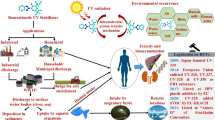Abstract
Population of white-rumped vulture has not recovered in India to a desired level even after diclofenac was banned in 2006. During 2019, there were two known separate incidents of white-rumped vulture mortality involving four white-rumped vultures in Gujarat. After post-mortem examinations, tissues of all four vultures were received for toxicological investigation at the National Centre for Avian Ecotoxicology, SACON. Tissues were screened for a set of toxic pesticides, and none of them was at detectable level. Subsequently, the tissues were analysed for thirteen NSAIDs and paracetamol. Of all the drugs tested, only nimesulide was detected in all the tissues (17–1395 ng/g) indicative of exposure. Visceral gout was also observed in all the four vultures during post-mortem. Residues of nimesulide in tissues with symptoms of gout indicated that the vultures died due to nimesulide poisoning. Although, other than diclofenac, many NSAIDs are suspected to be toxic to white-rumped vultures, only nimesulide is reported in the recent past with clear symptom of gout in wild dead white-rumped vultures similar to diclofenac. Since, nimesulide appears to act similar to diclofenac in exerting toxic effects, if veterinary use of nimesulide continues, white-rumped vulture are bound to suffer. Hence, it is recommended that nimesulide should be banned by the government to conserve white-rumped vulture in the Indian subcontinent. Further, an effective system is recommended to be put in place to collect the tissues of dead vultures for toxicological investigations and eventual conservation of the critically endangered species.




Similar content being viewed by others
References
Anastassiades M, Lehotay SJ, Štajnbaher D, Schenck FJ (2003) Fast and easy multiresidue method employing acetonitrile extraction/partitioning and “dispersive solid-phase extraction” for the determination of pesticide residues in produce. J AOAC Int 86(2):412–431
BirdLife International (2020) Species factsheet: Gyps bengalensis. http://www.birdlife.org accessed on 16/10/2020.
Business standard (2020) dated 13th April 2020, https://www.business-standard.com/article/printer-friendly-version?article_id= 120041301162_1https://, accessed on 20/11/2020.
Chaudhry JMI, Ogada DL, Malik RN, Virani MZ, Giovanni MD (2012) First evidence that populations of the critically endangered long-billed vulture Gyps indicus in Pakistan have increased following the ban of the toxic veterinary drug diclofenac in South Asia. Bird Cons Int 22:389–397
Cuthbert R, Pain DJ, Green RE, Swan G, Swarup D (2006) Comparative toxicity studies of NSAIDs in birds: a criticism of Reddy et al. Environ Toxicol Pharmacol 23:254–255. https://doi.org/10.1016/j.etap.2006.10.001
Cuthbert RJ, Dave R, Chakraborty SS, Kumar S, Prakash S, Ranade SP, Prakash V (2011) Assessing the ongoing threat from veterinary non-steroidal anti-inflammatory drugs to critically endangered Gyps vultures in India. Oryx 45(03):420–426. https://doi.org/10.1017/S0030605311000135
Cuthbert RJ, Taggart MA, Prakash V, Chakraborty SS, Deori P, Galligan T, Kulkarni M, Ranade S, Saini M, Sharma AK, Shringarpure R, Green RE (2014) Avian scavengers and the threat from veterinary pharmaceuticals. Phil Trans R Soc B: Biological Sciences 369(1656):20130574. https://doi.org/10.1098/rstb.2013.0574
Cuthbert RJ, Taggart MA, Saini M, Sharma A, Das A, Kulkarni MD, Deori P, Ranade S, Shringarpure RN, Galligan TH, Green RE (2016) Continuing mortality of vultures in India associated with illegal veterinary use of diclofenac and a potential threat from nimesulide. Oryx 50(01):104–112. https://doi.org/10.1017/S003060531500037X
Donati M, Conforti A, Lenti MC, Capuano A, Bortolami O, Motola D, Moretti U, Vannacci A, Rafaniello C, Vaccheri A, Arzenton E, Bonaiuti R, Sportiello L, Leone R, on behalf of DILI-IT Study Group (2016) Risk of acute and serious liver injury associated to nimesulide and other NSAIDs: data from drug-induced liver injury case–control study in Italy. Br J Clin Pharmacol 82(1):238–248
Eleni C, Neri B, Giannetti L, Grifoni G, Meoli R, Stravino F, Friedrich KG, Scholl F, Di Cerbo P, Battisti A (2019) Death of captive-bred vultures caused by flunixin poisoning in Italy. Environ Toxicol Pharmacol 68:91–93
Fourie T, Cromarty D, Duncan N, Wolter K, Naidoo V (2015) The safety and pharmacokinetics of carprofen, flunixin and phenylbutazone in the Cape vulture (Gyps coprotheres) following oral exposure. PlosOne 10:1–12. https://doi.org/10.1371/journal.pone.0141419
Galligan TH, Taggart MA, Cuthbert RJ, Svobodova D, Chipangura J, Alderson D, Prakash VM, Naidoo V (2016) Metabolism of aceclofenac in cattle to vulture-killing diclofenac. Conserv Biol 30(5):1122–1127. https://doi.org/10.1111/cobi.12711
Galligan TH, Bhusal KP, Paudel K, Chapagain D, Joshi AB, Chaudhary IP, Chaudhary A, Baral HM, Cuthbert RJ, Green RE (2019) Partial recovery of critically endangered Gyps vulture populations in Nepal. Bird Cons Int 30:87–102. https://doi.org/10.1017/S0959270919000169
Galligan TH, Mallord JW, Prakash VM, Bhusal KP, Alam AS, Anthony FM et al (2020) Trends in the availability of the vulture-toxic drug, diclofenac, and other NSAIDs in South Asia, as revealed by covert pharmacy surveys. Bird Conservation International:1–17. https://doi.org/10.1017/S0959270920000477
Green RE, Taggart MA, Das D, Pain DJ, Sashi Kumar C, Cunningham AA, Cuthbert R (2006) Collapse of Asian vulture populations: risk of mortality from residues of the veterinary drug diclofenac in carcasses of treated cattle. J Appl Ecol 43(5):949–956. https://doi.org/10.1111/j.1365-2664.2006.01225.x
Gupta G, Tiwari P, Ahlawat R (2012) A case of nimesulide toxicity in an Indian child. Indian Journal of Pharmacy Practice 5(2)
Hassan IZ, Duncan N, Adawaren EO, Naidoo V (2018) Could the environmental toxicity of diclofenac in vultures been predictable if preclinical testing methodology were applied? Environ Toxicol Pharmacol 64:181–186. https://doi.org/10.1016/j.etap.2018.10.006
Hindustan Times (2020) dated 24th April 2020, Guwahati, https://www.hindustantimes.com/india-news/19-vultures-die-in-a-day-in-assam-s-sibsagar-poisoning-suspected/story-mEr7EjPrs NjfEgc4hoMUiP.html, accessed on 20/11/2020.
ISDB (2007), Nimesulide must be withdrawn worldwide due to serious liver damage, press release on December 2007 by The International Society of Drug Bulletins (ISDB). https://www.ti.ubc.ca/2008/02/04/nimesulide-must-be-withdrawn-worldwide-due-serious-liver-damage/#:~:text=ckopp%40prescrire.org-,Nimesulide%20must%20be%20withdrawn%20worldwide%20due%20to%20serious%20liver%20damage,authorities%20fail%20to%20protect%20consumers. Accessed 10 Oct 2020
Muralidharan S, Dhananjayan V (2010) Diclofenac residues in blood plasma and tissues of vultures collected from Ahmedabad, India. Bull Environ Contam Toxicol 85(4):377–380. https://doi.org/10.1007/s00128-010-0109-7
Naidoo V, Wolter K, Cromarty D, Diekmann M, Duncan N, Meharg A et al (2010) Toxicity of non-steroidal anti-inflammatory drugs to Gyps vultures: a new threat from ketoprofen. Biol Lett 6(3):339–341
Naidoo V, Taggart MA, Duncan N, Wolter K, Chipangura J, Green RE, Galligan TH (2018) The use of toxicokinetics and exposure studies to show that carprofen in cattle tissue could lead to secondary toxicity and death in wild vultures. Chemosphere 190:80–89
Nambirajan K, Muralidharan S, Manonmani S, Kirubhanandhini V, Ganesan K (2018a) Incidences of mortality of Indian peafowl Pavo cristatus due to pesticide poisoning in India and accumulation pattern of chlorinated pesticides in tissues of the same species collected from Ahmedabad and Coimbatore. Environ Sci Pollut Res 25(16):15568–15576
Nambirajan K, Muralidharan S, Roy AA, Manonmani S (2018b) Residues of diclofenac in tissues of vultures in India: a post-ban scenario. Arch Environ Contam Toxicol 74(2):292–297
Oaks JL, Gilbert M, Virani MZ, Watson RT, Meteyer CU, Rideout BA, Shivaprasad HL, Ahmed S, Chaudhry MJI, Arshad M, Mahmood S (2004) Diclofenac residues as the cause of vulture population decline in Pakistan. Nature 427(6975):630–633. https://doi.org/10.1038/nature02317
Prakash V, Green RE, Pain DJ, Ranade SP, Saravanan S, Prakash N, Venkitachalam R, Cuthbert R, Rahmani AR, Cunningham AA (2007) Recent changes in populations of resident Gyps vultures in India. J Bombay Nat Hist Soc 104(2):129–135
Prakash V, Galligan TH, Chakraborty SS, Dave R, Kulkarni MD, Prakash N et al (2019) Recent changes in populations of critically endangered Gyps vultures in India. Bird Cons Int 29(1):55–70. https://doi.org/10.1017/S0959270917000545
Reddy NP, Anjaneyulu Y, Sivasankari B, Rao KA (2006) Comparative toxicity studies in birds using nimesulide and diclofenac sodium. Environ Toxicol Pharmacol 22(2):142–147
Sharma P (2012) Aceclofenac as a potential threat to critically endangered vultures in India: a review. Journal of Raptor Research 46(3):314–318
Shultz S, Baral HS, Charman S, Cunningham AA, Das D, Ghalsasi GR, Goudar MS, Green RE, Jones A, Nighot P, Pain DJ (2004) Diclofenac poisoning is widespread in declining vulture populations across the Indian subcontinent. Proc R Soc Lond B 271(Suppl 6):S458–S460
Swan GE, Naidoo V, Cuthbert R, Green RE, Pain DJ, Swarup D, Prakash V, Taggart M, Bekker L, Das D, Diekmann J (2006) Removing the threat of diclofenac to critically endangered Asian vultures. PLoS Biol 4(3):e66. https://doi.org/10.1371/journal.pbio.0040066
Swarup DPRC, Patra RC, Prakash V, Cuthbert R, Das D, Avari P, Pain DJ, Green RE, Sharma AK, Saini M, Taggart M (2007) Safety of meloxicam to critically endangered Gyps vultures and other scavenging birds in India. Anim Conserv 10(2):192–198. https://doi.org/10.1111/j.1469-1795.2006.00086.x
Taggart MA, Senacha KR, Green RE, Cuthbert R, Jhala YV, Meharg AA, Mateo R, Pain DJ (2009) Analysis of nine NSAIDs in ungulate tissues available to critically endangered vultures in India. Environ Sci Technol 43(12):4561–4566. https://doi.org/10.1021/es9002026
Zorrilla I, Martinez R, Taggart MA, Richards N (2015) Suspected flunixin poisoning of a wild Eurasian griffon vulture from Spain. Conserv Biol 29(2):587–592
Acknowledgements
We thank the Ministry of Environment, Forest and Climate Change, Government of India for financial support, Gujarat state forest department for granting permits to collect vulture samples, Mr Kartik Shastri, Jivdaya Charitable Trust, Ahmedabad for sharing invaluable vulture tissues, Mr A Kaja Maideen, Ms E Jeevitha and Mr T Manikandan for their assistance in laboratory, Mr B Karthikeyan, Spinco Biotech, Chennai and his team for LCMS technical support. We are beholden to Dr K Sankar, Director, SACON for his encouragement.
Availability of data and materials
The data generated during the current study are available from the corresponding author on request.
Funding
This study is part of a project work titled “National centre for surveillance and monitoring of impact of environmental contaminants on ecosystem components with special focus on birds in India”, funded by the Ministry of Environment, Forest and Climate Change, Government of India.
Author information
Authors and Affiliations
Contributions
Kanthan Nambirajan: conceptualization, investigation, methodology, chemical analyses, data curation, writing—original draft. Subramanian Muralidharan: funding acquisition, resources, conceptualization, investigation, supervision, writing—review & editing. Aditya Roy Ashimkumar: sample collection. Shashikant Jadhav: post-mortem examination.
Corresponding author
Ethics declarations
Ethical approval and consent to participate
Not applicable.
Consent for publication
Not applicable.
Conflict of interest
The authors declare no competing interests.
Additional information
Responsible Editor: Philippe Garrigues
Publisher’s note
Springer Nature remains neutral with regard to jurisdictional claims in published maps and institutional affiliations.
Supplementary Information
ESM 1
(DOCX 1935 kb)
Rights and permissions
About this article
Cite this article
Nambirajan, K., Muralidharan, S., Ashimkumar, A.R. et al. Nimesulide poisoning in white-rumped vulture Gyps bengalensis in Gujarat, India. Environ Sci Pollut Res 28, 57818–57824 (2021). https://doi.org/10.1007/s11356-021-14702-y
Received:
Accepted:
Published:
Issue Date:
DOI: https://doi.org/10.1007/s11356-021-14702-y




